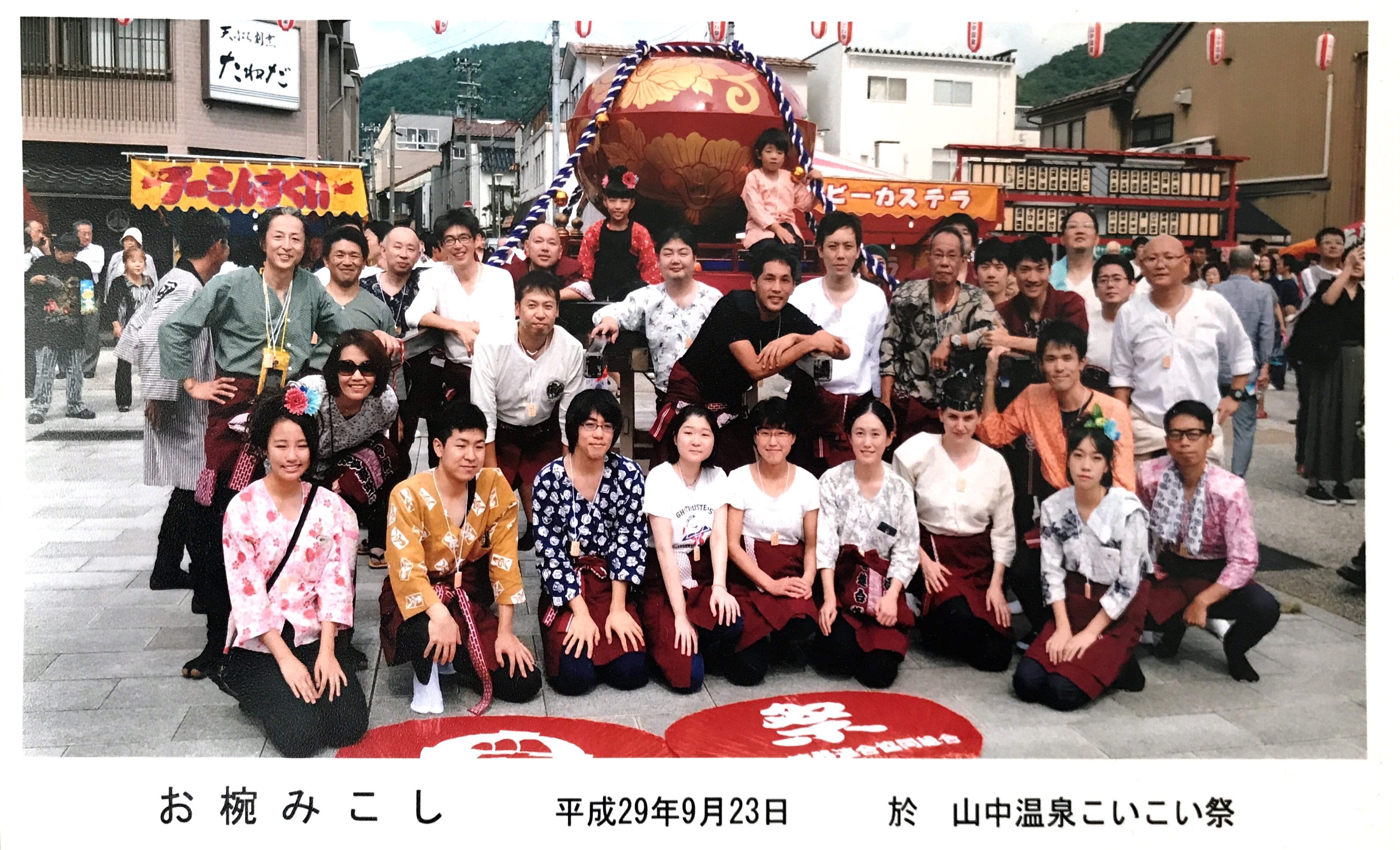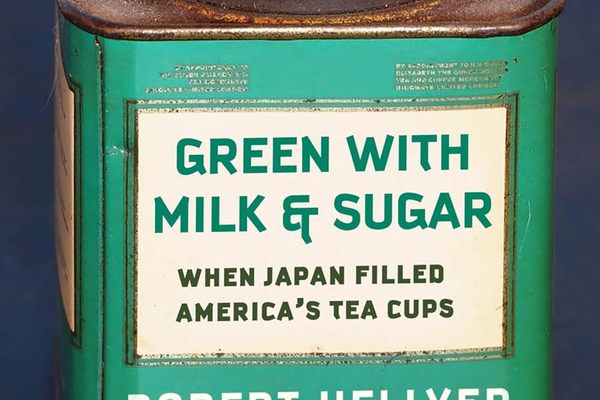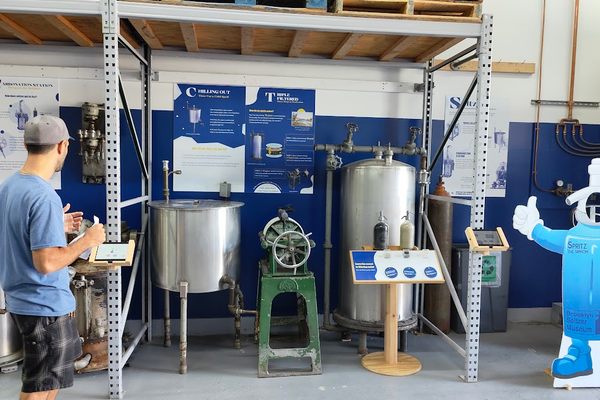The Annual Journey of a Giant Miso Soup Bowl
Every September in Yamanaka-Onsen, the owan-mikoshi gets a lift around town.

Every year in late September some two-dozen people parade a giant lacquerware owan (miso soup bowl) through the Japanese mountain town of Yamanaka-Onsen, shouting and stepping in unison as they carry it on four long support poles. Satiny purple tassels and grapefruit-sized bells sway and jingle as the bowl is hoisted in time with the group leader’s whistle. The carriers, flushed from the effort but also from drinking beer and sake since morning, wear matching costumes emblazoned with a bowl emblem, and split-toed tabi shoes.
They proceed through the town’s narrow streets, past vendors selling festival favorites like savory golden takoyaki and sweet-smelling baby castella cakes, entertaining spectators who emerge from small businesses and makeshift clubhouses. All this is part of Koi-koi Matsuri, literally “come-on come-on festival,” Yamanaka-Onsen’s biggest town-wide celebration. Nearly every town in Japan has a matsuri (festival) around when the rice is ready to reap, but contemporary autumn matsuri are as much street fairs as harvest celebrations. This scene is familiar to anyone from Japan, but the giant bowl is unique.
O-mikoshi, these manpowered parade floats, are portable shrines for carrying a deity through a festival. In Shintoism everything has a spirit, even a bowl. Usually o-mikoshi (the “o” is honorific, uttered in respect) look something like the Shinto shrines they originate from. But the bowl-shaped owan-mikoshi—carried by wood-turners and lacquer painters—isn’t associated with a shrine. It starts and ends its annual journey at the Yamanaka Lacquerware Traditional Industry Hall (henceforth, the Lacquerware Hall), a museum, shop, and educational center for preserving and promoting the local craft.

Yamanaka-Onsen is famous for two things: onsen (hot springs) and lacquerware, wooden cups and bowls turned on a lathe and finished with urushi (lacquer made from sap). Craftsmen have produced their wooden wares here since the 1500s, and the tradition of o-mikoshi in general dates back more than a thousand years, but the owan-mikoshi debuted in 1969. It’s appearance was cancelled (along with many other festival events) in 2009 when Koi-koi Matsuri briefly lost government funding, but a couple of people, nearly the same age as the original big bowl, revived it the next year with a band of volunteer craftspeople.
The owan-mikoshi group—whether because they are progressive or just in need of extra hands—includes women. Traditionally, only men carry o-mikoshi, and that’s still true in some places. Recently girls’ and women’s mikoshi teams have formed, but it’s still rare to see men and women carrying one together.
The makers of the original giant bowl improvised a large lathe, using a cement mixer to rotate the two-meter (6.5 foot) diameter bowl as they shaved it into a typical owan shape. The bowl was made of polyurethane, not wood, but even so, the assembled owan-mikoshi weighed 200-300 kilograms (about 500-600 pounds). Were you to fill that owan with miso soup, it could hold 1,206 liters (318 gallons). Real gold maki-e (ornamental painting with urushi and precious metal powders) decorates the shiny red synthetic lacquer. The original giant owan was retired in 2001 and replaced with a slightly smaller and lighter second generation, molded from fiberglass. You can view the restored original, and a plaque with its stats, year-round in the front window of the Lacquerware Hall.

Though the parade isn’t until mid-afternoon, the mikoshi-bearers arrive at the Lacquerware Hall parking lot by 10 a.m. to attach the owan to the carrying poles and dress it up with tasseled ropes and bells. At 10:30, everyone goes inside the museum and changes into costume. Instead of the typical short-shorts that mikoshi-bearers don, often shirtless, these craftsmen wear an old style of slim wrap-around pants, and a collarless button-down shirt. Over that, they put on a happi (a loose-fitting collarless jacket) tied with an obi (sash). They pull down the top of the jacket, tying the wide sleeves around their waist like an apron, with the bowl emblem squarely displayed across their behinds.
At 11 a.m., it’s time for rehearsal. In places famous for their o-mikoshi, like Tokushima or Asakusa, the teams are more disciplined, but this decidedly amateur group meets just once a year on the day of the festival. One of the leaders demonstrates correct form for the new members: rest the carrying beam on your shoulder, wrap your arm under and your hand over the beam, put your other hand on your hip, and bend your knees so you bounce when you step. The bearers are arranged by height, with the tallest in front bearing most of the weight. According to Takehito Nakajima, one of the leaders, good looks and/or social status are also preferred for the front center positions, called the hana-bou. The team practices the pattern of clapping, marching, shouting, and hoisting the poles overhead, practically tossing the bowl in the air three times before lowering it back to their shoulders.
After a break for lunch—pink paper bento boxes stacked on cafeteria tables among beer cans and ashtrays—a Shinto priest comes to call the spirit into the owan-mikoshi. Dressed in a turquoise robe and a sheer peach cloak, with a glittering black hat, he utters a blessing and shakes a branch and an onusa (a stick fringed with strips of paper, like a spiritual feather-duster) to symbolically cleanse the mikoshi. The hushed group periodically bows in unison. When the blessing and bowing is finished, prayer-engraved pendants and cups of ceremonial sake are passed around. Solemnity breaks into celebration.

The half-mile journey down a busy street into the town center begins just before 1 p.m. At least two dozen people push the owan-mikoshi on a wheeled cart while the leaders guide them through intersections. Others carry enormous paper fans to cool the team, or follow along to switch places with one of the 25 bearers when someone gets tired of lifting. A small girl and boy, children of one of the leaders, ride on purple satin cushions beneath the bowl.
The first stop is the local sake brewery. At the sound of the leader’s whistle, the bearers clap out a rhythm and then hoist the mikoshi onto their shoulders, marching up to the storefront and tossing the bowl as they shout, “Orya!” “Sa–!” in call and response. (Different regions have different chants, and no one knows for sure what—if anything—they mean.) The performance is rewarded with cups of newly-released autumn sake.
At the town center, lively with spectators and street stalls, the owan-mikoshi joins a classic shrine-shaped o-mikoshi, a rowdy dragon-mikoshi, and an all-girls mikoshi for another blessing. From a high circular stage in the middle of the plaza beside the onsen bathhouses, Buddhist monks toss hot spring water on the bearers, until their clothing is warm and damp. (Though the o-mikoshi is a Shinto tradition, both Buddhism and Shintoism influence even secular life in Japan, much as Christianity does in America.)

After a professional group photo, the mikoshi parade begins in earnest. The owan rolls out with the other o-mikoshi behind a flat-bed truck full of geisha singing local folk music and strumming shamisen. For hours, o-mikoshi roam the town, performing at important businesses and clubhouses in exchange for drinks and sometimes snacks. There’s sake, beer, sports drinks, and tea. The whole town is in festival mode, electric with revelry. The mikoshi bearers get louder and more enthusiastic with each performance, even as their shoulders bruise and arms ache.
The owan-mikoshi’s tour ends back where it started at the Lacquerware Hall, where the bowl and its deity will rest until next year’s celebration. By 5 p.m., the mikoshi team has finished disassembling the owan from the frame and poles and returned it to storage inside the hall. They all head home to shower before joining the festival with the rest of the town—now as spectators, not spectacle—to eat fried food and drink late into the night. On Monday, they’ll be back at work as craftspeople, but today is for revelry.
Gastro Obscura covers the world’s most wondrous food and drink.
Sign up for our regular newsletter.



























Follow us on Twitter to get the latest on the world's hidden wonders.
Like us on Facebook to get the latest on the world's hidden wonders.
Follow us on Twitter Like us on Facebook